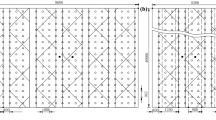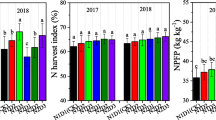Abstract
Field experiments were conducted from 2012 to 2015 in an arid region of Northwest China to investigate the effects of planting density on plant growth, yield, and water use efficiency (WUE) of maize for seed production. Five planting densities of 6.75, 8.25, 9.75, 11.25 and 12.75 plants/m2 were conducted in 2012, and a planting density of 14.25 plants/m2 was added from 2013 to 2015. Through comparison with the AquaCrop yield model, a modified model was developed to estimate the biomass accumulation and yield under different planting densities using adjustment coefficient for normalized biomass water productivity and harvest index. It was found that the modified yield model had a better performance and could generate results with higher determination coefficient and lower error. The results indicated that higher planting density increased the leaf area index and biomass accumulation, but decreased the biomass accumulation per plant. The total yield increased rapidly as planting density increased to 11.25 plants/m2, but only a slight increase was observed when the density was greater than 11.25 plants/m2. The WUE also reached the maximum when planting density was 11.25 plants/m2, which was the recommended planting density of maize for seed production in Northwest China.
Similar content being viewed by others
References
Akmal M, Asim M, Gilbert M. 2014. Influence of seasonal variation on radiation use efficiency and crop growth of maize planted at various densities and nitrogen rates. Pakistan Journal of Agricultural Sciences, 51(4): 835–846.
Allen R G, Pereira L S, Raes D, et al. 1998. Crop evaporation: guidelines for computing crop water requirements. In: FAO Irrigation and Drainage Paper No. 56. Rome: FAO, 300.
Coetto E, Di Candillo M, Castelli F, et al. 2013. Comparing solar radiation interception and use efficiency for the energy crops giant reed (Arundo donax L.) and sweet sorghum (Sorghum bicolor L. Moench). Field Crops Research, 149: 159–166.
Cox W J, Otis D J. 1993. Grain and silage yield responses of commercial corn hybrids to plant densities. In: Agronomy Abstracts. Madison, Wisconsin: American Society of Agronomy, 132.
Dai J L, Li W J, Tang W, et al. 2015. Manipulation of dry matter accumulation and partitioning with plant density in relation to yield stability of cotton under intensive management. Field Crops Research, 180: 207–215.
DeLougherty R L, Crookston R K. 1979. Harvest index of corn affected by population density, maturity rating, and environment. Agronomy Journal, 71(4): 577–580.
Duncan W G. 1986. Planting patterns and soybean yields. Crop Science, 26(3): 584–588.
El-Hendawy S E, El-Lattief E A A, Ahmed M S, et al. 2008. Irrigation rate and plant density effects on yield and water use efficiency of drip-irrigated corn. Agricultural Water Management, 95(7): 836–844.
Fulton J M. 1970. Relationships among soil moisture stress, plant populations, row spacing and yield of corn. Canadian Journal of Plant Science, 50(1): 31–38.
Griesh M H, Yakout G M. 2001. Effect of plant population density and nitrogen fertilization on yield and yield components of some white and yellow maize hybrids under drip irrigation system in sandy soil. In: Horst W J, Schenk M K, Bürkert A, et al. Plant Nutrition. Dordrecht: Springer, 810–811.
Harper L A, Pallas J E Jr, Bruce R R, et al. 1979. Greenhouse microclimate for tomatoes in the southeast USA. American Society for Horticultural Science, 104(5): 659–663.
Hashemi-Dezfouli A, Herbert S J. 1992. Intensifying plant density response of corn with artificial shade. Agronomy Journal, 84(4): 547–551.
Holt D F, Timmons D R. 1968. Influence of precipitation, soil water, and plant population interactions on corn grain yields. Agronomy Journal, 60(4): 379–381.
Jiang X L, Kang S Z, Tong L, et al. 2014. Crop coefficient and evapotranspiration of grain maize modified by planting density in an arid region of northwest China. Agricultural Water Management, 142: 135–143.
Johnsonb R R, Green D E, Jordan C W. 1982. What is the best soybean row width? A U.S. perspective. Crops and Soils Magazine, 43(4): 10–13.
Kamel M S, El-Raouf M S, Mahmoud E A, et al. 1983. Response of two maize varieties to different plant densities in relation to weed control treatments. Annals of Agricultural Sciences, 19: 79–93.
Karlen D L, Camp C R. 1985. Row spacing, plant population, and water management effects on corn in the Atlantic Coastal Plain. Agronomy Journal, 77(3): 393–398.
Lang A L, Pendleton J W, Dungan G H. 1956. Influence of population and nitrogen levels on yield and protein and oil contents of nine corn hybrids. Agronomy Journal, 48(7): 284–289.
Legates D R, McCabe G J Jr. 1999. Evaluating the use of “goodness-of-fit” measures in hydrologic and hydroclimatic model validation. Water Resources Research, 35(1): 233–241.
Lemcoff J H, Loomis R S. 1986. Nitrogen influences on yield determination in maize. Crop Science, 26(5): 1017–1022.
Li S E, Kang S Z, Li F S, et al. 2008. Evapotranspiration and crop coefficient of spring maize with plastic mulch using eddy covariance in northwest China. Agricultural Water Management, 95(11): 1214–1222.
Loomis R S, Connor D J. 1992. Crop Ecology: Productivity and Management in Agricultural Systems. Cambridge, UK: Cambridge University Press.
Mohamed M M A. 1999. Effect of some agronomic practices on corn production (Zea mays L.) under drip irrigation system. PhD Dissertation. Ismailia, Egypt: Faculty of Agriculture, Suez Canal University, 107.
Olson R A, Sander D H. 1988. Corn production. In: Sprague G F, Dudley J W. Corn and Corn Improvement (3rd ed.). Madison, WI: American Society of Agronomy, 639–686.
Papadopoulos A P, Pararajasingham S. 1997. The influence of plant spacing on light interception and use in greenhouse tomato (Lycopersicon esculentum Mill.): a review. Scientia Horticulturae, 69(1–2): 1–29.
Qiu R J, Song J J, Du T S, et al. 2013. Response of evapotranspiration and yield to planting density of solar greenhouse grown tomato in northwest China. Agricultural Water Management, 130: 44–51.
Raes D, Steduto P, HsiaoT C, et al. 2009. AquaCrop–The FAO crop model to simulate yield response to water: II. Main algorithms and software description. Agronomy Journal, 101(3): 438–477.
Raes D, Steduto P, Hsiao C, et al. 2011. AquaCrop Version 3.1Plus Reference Manual. Rome, Italy: FAO.
Rahmati H. 2009. Effect of plant density and nitrogen rates on yield and nitrogen efficiency of grain corn. World Applied Science Journal, 7(8): 958–961.
Rana G, Katerji N. 2000. Measurement and estimation of actual evapotranspiration in the field under Mediterranean climate: a review. European Journal of Agronomy, 13(2–3): 125–153.
Sangoi L, Gracietti M A, Rampazzo C, et al. 2002. Response of Brazilian maize hybrids from different eras to changes in plant density. Field Crops Research, 79(1): 39–51.
Soliman F H, Goda A S, Ragheb M M, et al. 1995. Response of maize (Zea mays L.) hybrids to plant populations density under different environmental conditions. Hip International, 23(6):124–124.
Steduto P, Hsiao T C, Raes D, et al. 2009. AquaCrop-the FAO crop model to simulate yield response to water: I. Concepts and underlying principles. Agronomy Journal, 101(3): 426–437.
Tetio-Kagho F, Gardner F P. 1998. Responses of maize to plant population density. II. Reproductive development, yield, and yield adjustments. Agronomy Journal, 80(6): 935–940.
Thimmappa V, Reddy M S, Reddy U, et al. 2014. Effect of nitrogen levels and plant densities on growth parameters, yield attributes and yield of kharif maize (Zea mays L.). Crop Research, 47(1–3): 29–32.
Westgate M E, Forcella F, Reicosky D C, et al. 1997. Rapid canopy closure for maize production in the northern US corn belt: Radiation-use efficiency and grain yield. Field Crops Research, 49(2–3): 249–258.
Acknowledgements
We are grateful for the research grants from the National Natural Science Foundation of China (51379208, 91425302, 51621061), the Government Public Research Funds for Projects of the Ministry of Agriculture (201503125) and the Discipline Innovative Engineering Plan (111 Program, B14002).
Author information
Authors and Affiliations
Corresponding author
Rights and permissions
About this article
Cite this article
Jiang, X., Tong, L., Kang, S. et al. Planting density affected biomass and grain yield of maize for seed production in an arid region of Northwest China. J. Arid Land 10, 292–303 (2018). https://doi.org/10.1007/s40333-018-0098-7
Received:
Revised:
Accepted:
Published:
Issue Date:
DOI: https://doi.org/10.1007/s40333-018-0098-7




